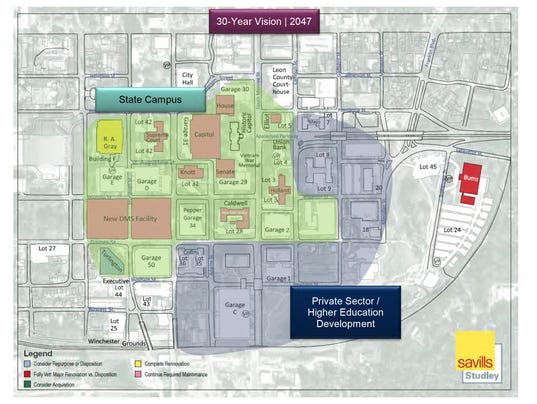http://www.tallahassee.com/story/news/2017/03/17/state-proposes-huge-reduction-downtown-office-space/99162014/?utm_source=dlvr.it&utm_medium=twitter

A report is calling for the state to sell off almost half of its buildings between the Capitol and Cascades Park – a move that would radically change downtown Tallahassee and create significant opportunities for private development.
Many of those are landmark buildings that date back to the Hoover and Eisenhower administrations and include the headquarters for the Department of Agriculture and Consumer Services, the Fish and Wildlife Conservation Commission, and the Department of Corrections.
The recommendations are part of a 258-page report from Savills Studley Occupational Services, commissioned by the Department of Management Services, to address the state’s long-range office space needs in Leon County, where the largest concentration of state employees live and work. The Legislature approved funding for the $772,655 study.
Those strategies would open up sites for private sector development that could create jobs, infill urban blight and boost tax revenues, said Jay Revell, vice president of the Greater Tallahassee Chamber of Commerce.
The state would continue to operate strategic assets in the downtown core but get rid of outlying buildings adjacent or close to Cascades park. One of those swaps would include trading the Coleman Building for land owned by the City of Tallahassee on Gaines Street between Duval Street and Martin Luther King Jr. Boulevard.
By the year 2047, the state's downtown core will be modernized and more compact, with a new wave of private development bordering Cascades Park. The state could then renovate the R.A. Gray Building and decide whether to unload the Burns building. It also could shift its focus to developing the Commonwealth area in northwest Tallahassee near I-10 and Capital Circle NW. where the copper-glass Douglas Building stands.
Renovate or wrecking ball?
Consultants have identified several state-owned buildings downtown that are near the end of their usefulness and marked as "disposition candidates." Here is a hit-list of facilities that state officials will weigh the cost of renovating with selling them off to private developers.Mayo Building, 407 S. Calhoun Street
Year built: 1937
Head count: 260
Issues: Reaching "functional obsolescence." HVAC issues.
Recommendation: Dispose of property or enter public-private partnership to renovate
Bryant Building, 620 S. Meridian Street
Year built: 1963
Head count: 190
Issues: Structural deficiencies, unsuitable for long-term needs, inefficient use of space. Boiler replaced
Recommendation: Dispose of property or explore public-private partnership to renovate
Elliot Building, 401 S. Monroe Street
Year built: 1962
Head count: 26
Issues: Lots of unused space
Recommendation: Sell or renovate and hold as swing space for Capitol.
Carlton Building, 501 S. Calhoun Street
Year built: 1956
Head count: 648
Issues: Not renovated to accommodate DOC in 2011; low efficiency, won't last another 30 years
Recommendation: "Strong disposition candidate to offset costs of new downtown facility."
Coleman Building, 468 E. Gaines Street
Year built: 1963
Head count: 12
Issues: Inefficient use of space
Recommendation: Swap with City of Tallahassee for two blocks north of Turlington Building.
Collins Building, 107 W. Gaines Street
Year built: 1962
Head count: 500
Issues: lots of structural deficiencies, inefficient use of space
Recommendation: Explore disposition or modernization over the next 5-10 years.
Holland Building, 600 S. Calhoun Street
Year built: 1949
Head Count: 99
Issues: Least efficient use of space
Recommendation: Major renovation and modernization, or sell to private entity
TOP TAKEAWAYS
Recommendations from Savills Studley include:
- Renovate and modernize more than 750,000 square feet of rentable space that houses more than 20 percent of the current workforce in Leon County.
- Addressing Americans with Disabilities Act deficiencies and other shortcomings in buildings that have long-term strategic value.
- Consolidate state buildings downtown into a more compact footprint.
- Create a downtown corridor for private sector and higher education development by getting rid of inefficient but valuable properties currently occupied by state workers.
- Cut privately leased space by 350,000 square feet to save $200 million in rent over the next 30 years.
No comments:
Post a Comment